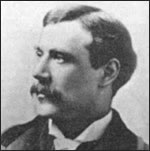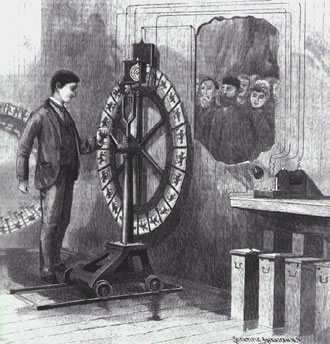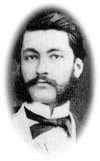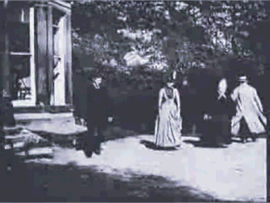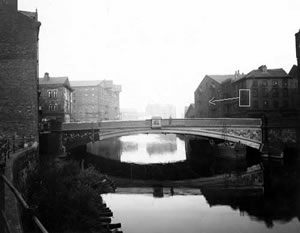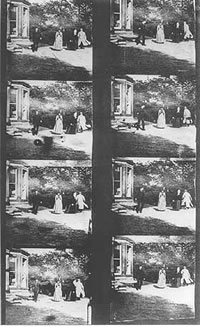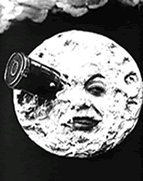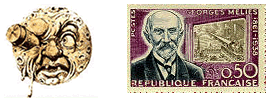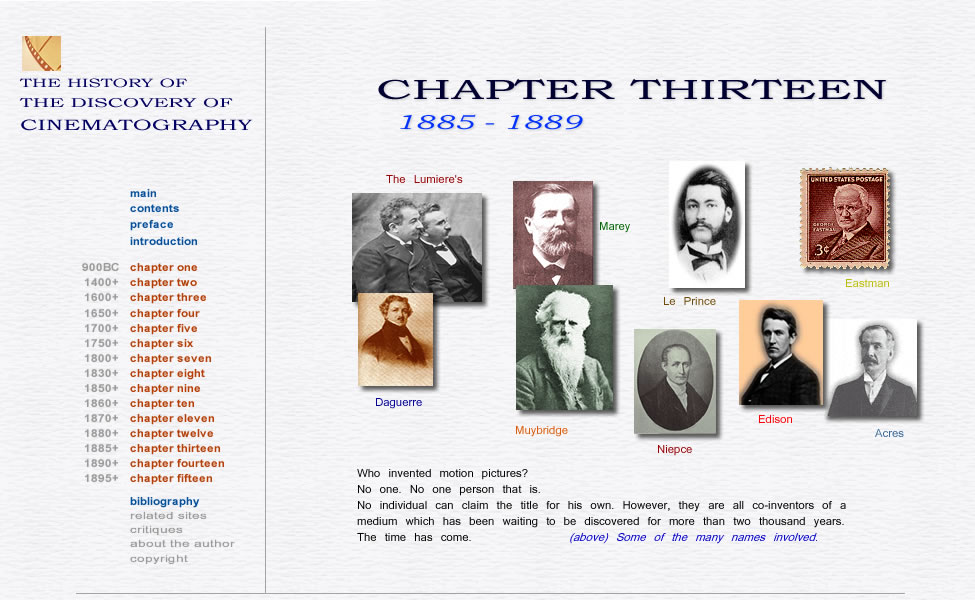 |
| |
|
|
|
| |
|
|
|
| |
|
|
|
| |
1885
ERNST MACH (1838 - 1916) |
|
|
| |
Mach was a professor in
Prague. He photographed the passage of fast-moving objects clearly showing
the sound waves breaking the air in excess of 760 miles per hour. Electrical
illumination was triggered when the objects struck wires prior to impacting
glass targets, creating a spark effect. |
|
| |
|
|
|
| |
|
|
|
| |
|
|
| |
1885
WILLIAM EDWARD FRIESE-GREENE (1855 - 1921)
Friese-Greene
uses what could be considered the earliest form of film, oiled paper. |
|
| |
William
Friese-Greene |
|
|
| |
|
|
| |
|
|
| |
|
|
| |
1885
LOUIS AIME AUGUSTIN LE PRINCE (1841 - 1890)
Le Prince begins initial work
on his motion picture experiments and in 1886 applies
for a patent for the production of animated pictures.
|
|
| |
|
|
|
| |
|
|
|
| |
1886
C. P. STIRN ( - ) |
|
|
| |
In keeping with the secretive
and hidden cameras of Herigone and Zahn, Stirn presents a ‚€˜Vest
Camera‚€™, which takes pictures through a buttonhole. It took multiple
exposures on a plate the size of a 4-inch plate. Within four years Stirn
will sell 18,000 of them. |
|
| |
|
|
|
| |
|
|
|
| |
1886
OTTOMAR ANSCHUTZ (1846 - 1907) |
|
|
| |
The Schnellseher
of Anshutz (soon to be better known in the west as the Tachyscope)
is introduced in Germany. Tachyscopes were introduced
into the U.S. later in the decade, perhaps as early as 1887. It has been
suggested that Anschutz was the most influential of the motion photographers
in the work of Thomas Edison. |
|
| |
|
|
|
| |
|
|
|
| |
1887
WILLIAM EDWARD FRIESE-GREENE (1855 - 1921) |
|
|
| |
Friese-Greene had been
working on synchronizing the Phonograph with the projector
he was working on. As history dictates, he never accomplished this dream
even though he wrote to Edison with no response. His papers do however
quote him as writing; |
|
| |
|
|
|
| |
"Why should
not moving pictures be combined with records of other sounds - all sounds,
speech, traffic, the thud of horses' feet on the turf, the striking of
the ball on bat at a cricket match, the sounds of human speech? Synchronization
of sound and sight was surely only a matter of improvement in mechanism." |
|
| |
|
|
|
| |
|
|
|
| |
|
|
| |
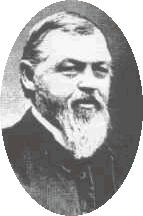 |
1887
HANNIBAL WILLISTON GOODWIN (1822 - 1900)
This
full-time Pastor and part-time inventor desired to improve on the
ability of the magic lantern to project better images to his Sunday
school members. In 1887 Goodwin filed for patent, a new flexible
medium known as Cellulose roll film. It was transparent,
tough, yet flexible. He patented it under the name of Photographic
Pellicle. His patent took eleven years to be finally granted,
in 1898. Marey immediately began to use this new roller film in
his work.
Hannibal
Goodwin |
|
|
| |
|
|
|
| |
|
|
|
| |
|
|
| |
|
|
|
| |
 |
1887
EADWEARD JAMES MUYBRIDGE (1830 - 1904)
Muybridge
publishes his 100,000 plus photos in 'Animal Locomotion-
An Electro-photographic Investigation of Consecutive Phases of Animal
Movements'. There were over seven hundred plates, all folio-sized,
in eleven volumes. This work is today a reference source in motion
study and is considered the most exhaustive analysis ever made of
the subject. When seen through the Zoopraxiscope
(as early as 1879), Muybridge's photographs are without
debate, the world's first motion pictures. Men, women, children
and animals are seen as in true motion, resembling nothing less
in quality or appearance than the earliest works of the Lumiere's
in 1895. Muybridge's final accomplishment was without Celluloid,
yet fluid, preceding the commercial films of the 1890's by at least
16 years. When considering the fact that there are 172,800 + frames
in a typical two hour film of today, Muybridge's 20,000 pictures,
if shown consecutively (impossible with the Zoopraxiscope)
would provide a film of approximately 13+ minutes in length. In
comparison, The Great Train Robbery of 1912 (Edwin
Porter) was 12 minutes, and Chaplin's Behind the Screen
of 1916, was 15 minutes. Muybridge of course, was not using Celluloid.
|
| Muybridge's
Zoopraxiscope |
|
|
|
| |
|
|
|
| |
|
|
|
|
|
|
| |
|
|
|
| |
1887
OTTOMAR ANSCHUTZ (1846 - 1907)
Anschutz uses a Geissler vacuum tube to illuminate his Electrotachyscope
{Electrical Tachyscope}. The instrument was unable because
of its construction and design to be viewed by more than a handful
at once, as opposed to a projecting device, which could entertain
hundreds. The Electrotachyscope (based again
on the concept of the Zoetrope almost exactly)
operated as a large stroboscopic disk revolving rapidly. It held
around it‚€™s circumference, the photographs which were illuminated
by an initial spark thereby providing ‚€˜electric
rapid vision.‚€™ The viewer(s) watched the motion at around eye level.
The disk contained fewer than 100 images, limiting it‚€™s use almost
from the start. Disks were not the way of the future as Kamm discovered.
The Electrotachyscope was exhibited in 1893 at
the World‚€™s Fair in Chicago. Anschutz was one of the first to take
photographs successively and instantaneously. His photographs for
the Electrotachyscope were taken beginning in 1885.
The Philadelphia Photographer of 1887 (June 4 edition) had this
to say of Anschutz; ‚€œthe photographer,
Anschutz, of Lissa, has an apparatus . . . for the most stroboscopic
combination of the motion pictures produced by him.‚€œ
The
Electrotachyscope or Electrical Tachyscope
(right) of Ottomar Anschutz. |
|
|
|
|
| |
|
|
|
| |
|
|
| |
|
|
|
| |
|
|
|
| |
1887
THOMAS ALVA EDISON (1847 - 1931) |
|
|
| |
Edison is always looking
into the future while working on the present. He begins to develop another
motion picture projector that will unite his Phonograph
with the Kinetoscope thereby providing sound to match
the pictures. In his first caveat (Motion Picture Caveat 1) of
1888, Edison began with; ‚€œI am experimenting
upon an instrument which does for the Eye what the phonograph does for
the Ear . . ." |
|
| |
If you want someone to write a cinematography essay
for you, contact
this site to get it written by essay experts. |
|
| |
|
|
|
| |
|
|
| |
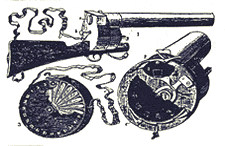
Inner Workings of the Fusil Photographique |
1888
√‰TIENNE-JULES MAREY (1830 - 1904)
Marey
produced a new Chronophotographic camera using
rolls of paper instead of glass plates. He provided this information
to the Academie des Sciences. Marey was able to take as many as
forty frames at a time. Marey's revolving disk gun cameras achieved
high speeds and much shorter intervals than Muybridge's method.
They were also lighter, less cumbersome and therefore portable.
Later in 1889, Marey further communicated to the Academie on his
experiments and progress; |
| ‚€œTo
complete the researches which I have communicated to the Academy
at recent sessions [1888] I have the honour to present today a band
of sensitized paper upon which a series of impressions has been
obtained, at the rate of twenty per second. The apparatus which
I have constructed for this purpose winds off a band of sensitized
paper with a speed which may reach 1m, 60 per second, as this speed
exceeds my actual needs I have reduced it to 0m, 80. If the impressions
are taken while the paper is in motion, no clearness will be obtained,
and only the changes of position of the subject experimented upon,
will be apparent. But if, by means of a special device, based upon
the employment of an electro-magnet, the paper is arrested during
the period of exposure, 1/5000 of a second, the impression will
possess all the clearness that is desirable. This method enables
me to obtain the successive impressions of a man or of an animal
in motion, while avoiding the necessity of operating in front of
a black background. It seems moreover destined to greatly facilitate
the studies of the locomotion of men and animals." |
|
|
| |
|
|
| |
|
|
|
|
|
|
| |
|
|
|
| |
1888
JOHN WESLEY HYATT ( - ) |
|
|
| |
Hyatt coins the phrase
'Celluloid' from the chemical term Cellulose.
He founds the Celluloid Manufacturing Company in Newark,
New Jersey. Hyatt is successful in producing optically clear Celluloid
sheets of just 0.01" thick. |
|
| |
|
|
|
| |
|
|
|
| |
1888
CHARLES-EMILE REYNAUD (1844 - 1918)
The first patent for an image-projection
device that incorporated perforations is granted this year. The projector
is that of Reynaud and is called the Théâtre Optique.
This machine is an extention of his original Praxinoscope
but is much larger and intended for public projection for a large audience.
This performance will take place
in 1892. SEE
THEATRE OPTIQUE 1892 |
|
| |
|
|
|
| |
|
|
|
| |
1888
JOHN CARBUTT ( - ) |
|
|
| |
Carbutt begins manufacture
of the first successful plastic-base sheet-films in Philadelphia from
the Celluloid Manufacturing Company. Where Hyatt improved on Parkes original
attempts, Carbutt now takes the Celluloid strips of Hyatt
and prepares them for photographic use. Carbutt announced his product
to the Photographic Society of Philadelphia and presented it to the Franklin
Institute when he said; |
|
| |
|
|
|
| |
‚€œThe substance
I have the honour to bring to your notice tonight is this sheet celluloid,
manufactured by the Celluloid Manufacturing Company. It is some three
or four years since I first examined into this material, but the manufacturers
had not then perfected the finish of it to render it available, and it
is only during this year that it has been produced in uniform thickness
and finish, and I am now using at my factory large quantities of sheet
celluloid 1/100 of an inch in thickness, coated with the same emulsion
as used on glass, forming flexible negative films, the most complete and
perfect substitute for glass I believe yet discovered . . . I will now
show on the screen lantern transparencies from film negatives, both contact
and reduced in the camera.‚€œ |
|
| |
|
|
|
| |
|
|
|
| |
1888
GEORGE EASTMAN (1854 - 1932) |
|
|
| |
Eastman continues research
and development of photographically prepared Celluloid
roll film for motion picture camera use. During Eastman's career, he was
quoted on the subject of light and the pinhole image, saying . . .
"Light makes photography. Embrace light. Admire it. Love it. But
above all, know light. Know it for all you are worth, and you will know
the key to photography". |
|
| |
|
|
|
| |
|
|
|
|
|
| |
1888
LOUIS AIME AUGUSTIN LE PRINCE (1841 - 1890)
A
Frenchman working primarily in Leeds England, who earlier had emigrated
to the U.S., Le Prince patents in the U.S., a camera and projector
described as having sixteen lenses
(however the application describes "one
or more lenses"). So close to being the first to
project moving pictures publicly, he also applied for international
patents in Belgium, Italy, Austria, Hungary, France, and in England,
which he would never live to see granted. In fact, the British patent
described among other things; flexible film, (positive and negative)
and intermittent movement in the shutter. His apparatus was
capable of showing animated pictures, which he had already presented
in the Whitley factory in Leeds (see below). An interesting
twist happens in the story of this man Le Prince. He disappeared
without a trace on September 16, 1890 while on a train from Dijon
to Paris. He was never found even though three detectives from three
countries investigated the disappearance. Not only was his body
never seen again, nor were his many papers he carried, as well as
his luggage. |
|
| |
|
Louis
A.A. Le Prince |
| An
excellent read on this mystery would be The Missing Reel,
by Christopher Rawlence, (Atheneum Publishers, New York 1990).
Le Prince was enroute to patent his device in London and then go
to New York for a public demonstration. After his disappearance,
the Le Prince family led by his wife and son went to court against
Edison in what became known as Equity 6928. The
famous Patent Wars ensued and by 1908 Thomas Edison
will be named sole inventor of motion pictures, in the U.S, at least.
However, in 1902, two years after Le Prince‚€™s son Adolphe had testified
in the suit, he was found shot dead on Fire Island, New York. Le
Prince‚€™s apparatus was eventually built by Herman Casler and was
used in taking pictures. A photograph of a drowning victim who resembled
Le Prince was found in Paris police archives in 2003. The picture
was from an investigation undertaken in 1890. The photograph referred
to can be seen
here at the Who's Who of Victorian Cinema website. |
| |
|
|
Earliest Extant
Film: Roundhay Garden Scene of 14 October, 1888 From Louis
Aime Augustin Le Prince
No other strip
of film has ever been produced which pre-dates this one.
It is known as the Roundhay Garden Scene
(right). Le Prince photographed this sequence
(2-3 weeks prior to Leeds) in the garden of the
Whitley home, (home of his father-in-law) Roundhay,
Leeds. This 'film' was never shown by Le Prince and exists
today only as a result of photographic copies of the original
paper frames (made by the NMPFT in 1930), and
reconstructed animations.
Le Prince's original pictures where photographed using
his 16-lens camera (the LPCC 16-lens camera)
and used Eastman Kodak film-paper. They were shot at sixteen
frames per second. Unlike Leeds, Roundhay had 'actors'
namely; Adolphe Le Prince (Louis' son), Sarah
Whitley (Louis' mother-in-law), Joseph Whitley
(factory owner where Le Prince worked) and Harriet
Hartley. The entire episode shows everyone walking around
in a circle. |
|
|
'Roundhay Garden Scene' Of 14 October 1888 |
| |
|
| Interestingly,
Le Prince never really gave his cameras and projectors a
name as did other inventors. They were simply known as the
single-lens or the 16-lens, or by the patent number. He
did however within his patents, title his cameras as "receivers"
and his projector as a "deliverer".
|
|
|
|
|
|
| |
| |
|
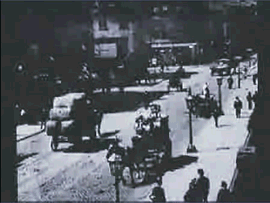 |
Second
Earliest Film: Leeds Bridge Traffic Scene of October
1888 From Louis A. A. Le Prince
Le Prince used
non-perforated sensitized Kodak roll-paper film for
these frames which remain twenty in all. These frames
show daily traffic crossing the River Aire in Leeds
England and were photographed in October 1888 by Le
Prince. According to Michael Harvey of the National
Museum of Photography, Film and Television
in London, "These
only exist today as photographic
copies, made in the 1930s, of parts of the paper film
strips".
Although never
shown publicly, or announced to the world, Le Prince
did present his cinematography of the "Leeds
Bridge Traffic" (also known as 'Traffic Crossing Leeds
Bridge') in the Whitley factory two years before
Donisthorpe and seven years before the Lumiere's cafe
presentation.
|
| |
|
|
| As the Roundhay
Garden Scene frames have been re-constructed into an
almost-real experience, so has the Leeds Bridge Traffic.
The twenty remaining frames (above) have been created
into a two-second looped animation showing how it may have looked
at that time. These pictures were taken shortly after the pictures
in the Whitley garden were filmed. Notice that even horses travelled
on the left in 1888 England. |
| |
|
| |
|
This photograph
(right) is of the newer iron-span bridge over the River
Aire in Leeds, which was built in 1945. The original stone bridge
was opened on 9 July 1873. The filming took place from a window
in the premises of Hick Brothers (the building of which
is still standing), which can be seen on the right side
of the photograph, directly above the bridge. The window Le
Prince used is within the white rectangle.
The arrow indicates the angle and direction from which Le Prince
made his historic footage. Adolphe Le Prince wrote on the taking
of this 'film'; "Portion of a
series taken by Le Prince with his second one-lens camera in
October, 1888. A view of the moving traffic on Leeds Bridge,
England. Taken at 20 pictures a second in poor light. His eldest
son was with him when he took the picture". -- Adolphe
Le Prince
The "second one-lens camera"
Adolphe was referring to was his father's LPCCP MKLL
single-lens camera patented in London and Paris (1888
& 1890) respectively. |
|
 |
1945
Picture Of The Leeds Bridge Identifying the Window (boxed)
And Angle (arrow) Le Prince Used When Photographng The
Traffic On The Bridge, late October, 1888 |
|
|
| |
|
|
| |
|
|
| |
Le Prince
quite likely, never knew the importance of his work or the impact these
two cinematographic episodes of common life would have on the world.
He did understand however, that he was one of many men working on the
very same thing during the very same decade. Both Leeds
and Roundhay were experimental films, taken during
the research and development stage of his work. None of his machines
( the LPCC 16-lens camera, the LPCCP MKL single-lens
camera, the LPCCP MKLL single-lens camera
and the LPP 3-lens projector) were anywhere close to
being perfected, but were all successfully patented in the United States,
England and France between 1888 and 1890.
The one exception was the LPCCP MKL single-lens camera
which was refused patent in the United States in 1888. These are the
most important cinematic events simply because they are the first ever
made using a continuous strip (paper or celluloid)
of individually photographed frames that were projected in sequence
providing fluid motion, in history.
|
|
| |
|
|
|
| |
|
|
|
| |
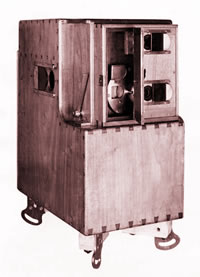 |
Influenced
By Other Pioneers
The Le Prince family knew Louis Daguerre and considered him
a friend. Daguerre had offered Louis some of his photographic
know-how in 1875. Louis Le Prince as well had seen much of the
work done by Eadweard Muybridge for Stanford. Le Prince wanted
to involve himself in the possibility of creating motion using
photographs.
By early 1888 Le Prince invited carpenter Frederic Mason to
make camera bodies, and James Longley to make the working parts.
By that summer Le Prince had designed and constructed two single-lens
cameras, one photographing at the speed of 12 frames per second
and the other at twenty fps. He takes pictures in the family
garden and at the bridge.
First using non-perforated paper roll film from Eastman, he
later began using celluloid due to non-stability of the paper
film in the machines. Le Prince also designed and constructed
a separate projector consisting of three bands, three lenses
and a Maltese Cross. |
|
| Le Prince's single lens
camera (above) [MK2] 1888, identified by his son Adolphe
as the "second one-lens camera"
in a written commentary referring to the Leeds Bridge filming. |
NOTE on ©:
The photograph to the left was found on websites not identifying
it as copyrighted, nor in the public domain, nor providing any
source. We feel from numerous other similar images and charactertistics
of this picture, it is likely from the NMM collection and identify
it as such. We have not found this image at NMPFT online.
Visit The NMM here. |
These
frames (above) are eight of what are left of the film
taken by Le Prince on 14 October 1888 in the Whitley garden. |
|
|
| |
|
|
|
| |
In his patent
for the single-lens camera (MK2, above) of 1888, Le Prince
identified the machine as a "Method And
Apparatus For
T he Projection of Animated Pictures In View Of The Adaptation To Operatic
Scenes". It photographed the now-famous scenes on 60mm
paper film at the rate of twelve frames per second (Roundhay)
and twenty frames per second (Leeds Bridge) according to Adolphe
Le Prince in later commentaries and who was present at both events and
seen on-screen in one.
|
|
| |
|
|
|
| |
|
|
| |
|
|
|
| |
1888
WILLIAM KENNEDY LAURIE DICKSON (1860 - 1935) |
|
|
| |
Working for Edison as
a co-inventor/employee, Dickson comes up with the Kinetograph,
the first Celluloid film motion picture
camera. The processed film was used in the Kinetoscope,
also invented by Dickson. The Kinetoscope was the first
continuous-film, motion picture projector. |
|
| |
|
|
|
| |
|
|
|
| |
|
|
| |
1888
MARIE GEORGES JEAN MELIES (1861 - 1938)
This
French magician can safely be referred to as the pioneer of fantasy
films and special effects on a large scale. Going by his second
name of Georges, Melies purchased the Robert-Houdin theatre this
year and took his profession as an illusionist to a new level. He
was a masterful theatrical showman to say the least. The combination
of having worked with the magic lantern, being a professional magician,
and a chance event with his camera allowed Melies to craft his career
into a true fantasist. The event involved the film in his camera
jamming while shooting on a street. After processing the film and
viewing it, Melies noticed that subjects had changed from this to
that disappeared and appeared and had appeared as fades
and dissolves. Melies began showing films in his
theatre from 1896 onward with split-screen effects, superimpositions,
fade-outs, slow and stop-motion, double exposures and dissolves
incorporated into the stories. His most famous film is perhaps remembered
as A Trip To The Moon of 1902. He made over
400 films before he died and did so, penniless. |
|
| |
Frame
from A Trip to the Moon |
|
|
| Georges Melies
life work was honored in more ways than only artistically. The French
government honoured him for his cinematic contribution in France
with a postage stamp bearing his image. The commercialization of
films forced him out of the movie-making business in 1913. He died
in poverty in 1938. |
| |
|
|
|
| |
|
|
| |
|
|
|
| |
|
|
|
| |
1888
THOMAS ALVA EDISON (1847-1931) and EADWEARD JAMES MUYBRIDGE (1830 - 1904) |
|
| |
Muybridge speaks with
Edison again, about the possibility of amalgamating his Zoopraxiscope
with Edison‚€™s Phonograph in the hopes of producing sound
pictures in the future. Edison was already considering this idea in his
New Jersey laboratories however it would be another forty years before
becoming a reality. Muybridge had been lecturing at Orange, New Jersey
at the invitation of the New England Society. On the contrary, Edison
disputes this mention, or at least his notes apparently did when it was
found in them that Edison scratched out the words . . . . .‚€œNo
--- Muybridge came to lab to show me picture of a horse in motion -- nothing
was said about phonograph.‚€Ě |
|
| |
|
|
|
| |
|
|
|
| |
1888
WILLEM HALLWACHS ( - ) |
|
| |
Hallwachs experimented
with the possibility of creating photoelectric cells for use in the camera.
A German physicist, Hallwachs demonstrated that some objects emit electrons
when exposed to sunlight. The television camera exists because of the
orthicon tube. This phenomenon is known as photoemission. |
|
|
|
|
|
| |
|
|
|
| |
1889
JOHN ARTHUR ROEBUCK RUDGE ( - ) and WILLIAM EDWARD FRIESE-GREENE (1855
- 1921) |
|
| |
Rudge and Friese-Greene
work together to devise an instrument called a Biophantic Lantern.
This device worked alongside the Biophantoscope (also
spelled Biophantascope) which would allow multiple
slides to be projected giving a strong impression of movement. Rudge's
work greatly influenced Friese-Greene who went on to photograph street
scenes and present them publicly this year. Rudge was a magic lantern
and instrument maker from Bath, England. Rudge also works on his
Phantascope. |
|
| |
|
|
|
| |
|
|
|
| |
|
|
| |
1889
WORDSWORTH DONISTHORPE and WILLIAM CARR CROFTS ( - ) |
|
| |
They jointly finish the
development of an apparatus Donisthorpe began in 1878. It projected a
Celluloid ribbon and maintained the name Kinesigraph.
In 1889 they patented it. The machine photographed at approximately 10
frames per second and 10 frames alone, are extant. Below is an amazing
recreation in animated form, from these actual frames that survive. The
frame below is Trafalgar Square, London, 1890 as photographed by Donisthorpe. |
|
| |
|
|
|
| |
 |
Donisthorpe's
Trafalgar Square Footage of 1890
In 1890 Wordsworth Donisthorpe
filmed the traffic at London's Trafalgar Square
with a camera he and Crofts had patented. This footage has not
been contested as the first motion picture ever taken of the city
of London.
This scene was never
shown publicly. History has not revealed its name, however this
machine, which was patented in 1889 allowed a continuous roll
of film to pass through the aperture evenly and smoothly. The
take-up reel and supply reel were almost synchronized as to provide
the stability needed to avoid tearing and flickering.
Donisthorpe was never
able to acquire backing for the project of moving pictures. Crofts
and Donisthorpe had previously created their Kinesigraph
in 1878.
Ten frames of the Trafalgar
Square footage (originally taken on paper) are extant
and have been digitized and created here (left) to show
how it may have looked in 1890.
|
| Donisthorpe's
remaining ten frames (above) taken in 1890 have been created
into an animation showing what this brief scene may have looked
like at the time. |
|
|
| |
|
|
| |
|
|
|
| |
|
|
|
| |
1889
WILLIAM EDWARD FRIESE-GREENE (1855 - 1921) |
|
|
| |
A British photographer,
Greene presents a short film using Celluloid film, and
his Cinematographic camera which used five frames per
second. He requests a British patent for it, which will be issued in 1891,
calling it an ‚€œImproved apparatus for taking
photographs in rapid series.‚€Ě An article appeared in the Optical
Magic Lantern Journal and Photographic Enlarger of this year
describing the apparatus; |
|
| |
|
|
|
| |
This
instrument is pointed at a particular object and by turning the handle
several photographs are taken each second. These are converted into transparencies,
and placed in succession upon a long strip, which is wound on rollers
and passed through a lantern of peculiar construction (also the invention
of Mr. Friese-Greene), and by it‚€™s agency projected upon a screen. When
the reproduction of speech is desired this instrument is used in conjunction
with the phonograph.‚€Ě |
|
| |
|
|
|
| |
|
|
|
| |
1889
LOUIS AIME AUGUSTIN LE PRINCE (1841 - 1890) |
|
|
| |
Le Prince uses sensitized
roll Celluloid for his Cinematograph. |
|
| |
|
|
|
| |
|
|
|
| |
1889
GEORGE EASTMAN (1854 - 1932) |
|
|
| |
Eastman's company begins
to manufacture Celluloid roll film for use in cameras.
Eastman also applies for a patent on his film. This now ends the period
where film stripping required a coating being peeled off prior to use.
Eastman‚€™s transparent film becomes a standard in an industry even before
it‚€™s commercial birth. |
|
| |
|
|
|
| |
|
|
|
| |
ca.1889 |
|
|
| |
During this time period
more and more ‚€˜detective‚€™ cameras roll off the production lines. Some
are in the shapes of ties, hats and even bags. |
|
| |
|
|
|
| |
|
|
|
| |
|
|
| |
| |
|
|
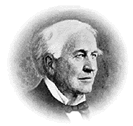 |
1889
THOMAS ALVA EDISON (1847 - 1931)
Edison
travels to Europe and meets Marey who shows Edison a device projecting
photographs by way of electricity. In New Jersey, Edison receives
specified roll film from George Eastman for use at his laboratories.
Edison applies for a patent on his Kinetoscope
and Kinetograph combination system, which takes
two years to receive. |
|
| Thomas
A. Edison |
|
Edison's
Kinetoscope |
|
|
| |
|
|
| |
|
|
|
| |
|
|
|
| |
1889
CHARLES-EMILE REYNAUD (1844 - 1918) |
|
|
| |
Takes out a patent in
Britain detailing more ideas to further his Praxinoscope
and Lamposcope. They include; using a band which is not
only continuous but infinite in length; advancing this concept with rollers
that contain the great length in the supply and take-up mode; using a
toothed band, to maintain smoothness and surety. The Praxinoscope
is known also as Praxinoscope Projecting Theatre, Optical
Theatre and Theatriaxinoscope. |
|
| |
|
|
|
| |
|
|
|
| |
|
|
|
| |
|
|
|
| |
|
|
|
| |
|
|
|
| |
|
|
|
| |
|
|
|
| |
|
|
|

|
| |


